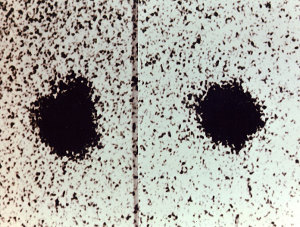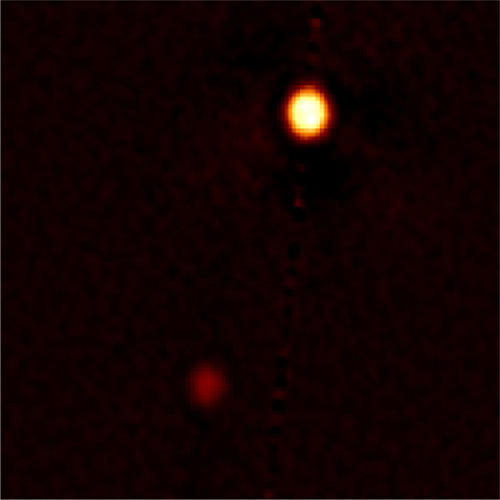
Our view of Pluto/Charon gets better and better as we prepare for the New Horizons flyby in 2015. It wasn’t so long ago that we had no idea Pluto had a single moon, much less the five we have so far identified. When James Christy (USNO) discovered Charon in 1978, he was looking at photographic plates of Pluto that showed little more than a slight bulge that appeared periodically. The bulge came into and out of view as the [dwarf] planet rotated, indicating a genuine object and not a flaw in the observation, but although Charon had been found, we couldn’t resolve separate disks until the Hubble Space Telescope’s images of the 1990s.
Image: Plates taken with the Kaj Strand Astrometric Reflector at the USNO Flagstaff Station in Arizona revealed the existence of Charon, visible as an elongation in the image. Later eclipses and occultations of Pluto and Charon confirmed the discovery. Charon has a mass of about 22 percent that of Pluto. Credit: Wikimedia Commons.
The Hubble images, unlimited by distortions from Earth’s atmosphere, have revealed much about Pluto/Charon. But take a look at another image, this one taken with the Gemini North 8-meter instrument. This is said to be the sharpest ground-based imagery of Pluto/Charon ever taken in visible light. These observations have not only verified the orbital characteristics of the two objects but are sharp enough to reveal their precise diameters. Steve Howell (NASA Ames), who led the study, says “The Pluto-Charon result is of timely interest to those of us wanting to understand the orbital dynamics of this pair for the 2015 encounter by NASA’s New Horizons spacecraft.”

The technique being used here is called reconstructive speckle imaging, made possible through mounting a camera called the Differential Speckle Survey Instrument (DSSI) onto the telescope. Using these methods, a large number of short exposure images are processed to remove the effects of atmospheric distortion. Each image was exposed for 60 milliseconds. Over the range of images, the light from the objects under observation could be separated from the transient artifacts caused by the atmosphere. The DSSI instrument and associated software were created by Elliott Horch (Southern Connecticut State University) and team in 2007. Detectors for the instrument were upgraded in late 2009, making possible the new levels of sensitivity shown here.
Image: Speckle image reconstruction of Pluto and Charon obtained in visible light at 692 nanometers (red) with the Gemini North 8-meter telescope using the Differential Speckle Survey Instrument (DSSI). Resolution of the image is about 20 milliarcseconds rms [root mean square]. This is the first speckle reconstructed image for Pluto and Charon from which astronomers obtained not only the separation and position angle for Charon, but also the diameters of the two bodies. North is up, east is to the left, and the image section shown here is 1.39 arcseconds across. Credit: Gemini Observatory/NSF/NASA/AURA.
Reconstructive speckle imaging is showing its stuff with Pluto/Charon, but the bigger picture is that the upgraded DSSI can be used in the exoplanet hunt. Kepler’s transit studies require follow-ups from other instruments to confirm the discoveries, and the original DSSI had been in use at Kitt Peak for this purpose. NASA’s Howell says that speckle imaging with the Gemini telescope will double the instrument’s ability to resolve objects, offering a 3- to 4- magnitude sensitivity increase for the sources the team needs to observe. The astronomer calls it “an enormous gain in the effort underway to confirm small Earth-size planets.”



Given the Pluto is a relatively large dwarf planet and has lots of very interesting ices, I suspect that it will actually become a major outpost for exploring the Kuiper belt. It should be much more accessible than Eris and is large enough to support a very large civilization , if you allow for some burrowing into the surface, or enclose the surface in a tent . Energy limitations would have to be overcome with fusion energy, but otherwise it has a lot of merit as a base of operations. eavier elements might be found in impact craters on the surface or perhaps some of the smaller moons might be melted down to recover non- volatiles. But as for the elements of life, there should be abundant CHO and N on or near the surface. I suspect it has a liquid water core, where salts might be captured to provide sulfur, phosphorus, sodium and potassium, as well as chlorides.
Because of the size of the Pluto and Charon, a human population might be able to reach a critical mass to sustain a post industrial ( extra -planetary) society, making high tech electronics, machinery, chemicals and medicines for the settlement of the outer solar system. From there, — the other stars of our galaxy are a slow crawl away.
I take it from the picture that Pluto is in the upper right hand corner and the moon to Pluto is in the left?
Moving to a off-topic subject – 100 year symposium in Houston, I was wondering Paul if you might be able to share with us some of the particulars regarding the meetings that you had privately in the first day of your visit to the city; if that would be okay.
Also too, did they indicate their feelings concerning the videotaping and online playbacks of the video for those who were nonattendees?
william, yes, Pluto is in the upper right corner; Charon is the much dimmer object at the bottom.
Re the meetings on the first day, I’m afraid I’m unable to discuss the particulars without violating confidentiality. I haven’t found out yet whether videotaping will be made available for this meeting, but will check again.
I have been keenly following this announcement ( http://www.gemini.edu/node/11893 ) .. Couple thoughts.. Yes it could be the “sharpest” image taken from Earth, I rather wait for a duplicate installation of this device & verification of the results. Am I to assume this device cannot record hence measure P2 thru P5 moons.. I have not seen the diameter results of the Binary Planet system (Pluto and Charon) yet.. any data?. wonder how its data matches to the Occultation data recorded from Earth.. Finally the sharpest (highest res) pics we have of the Binary system and its 4 moons are taken from HST.. right?.. Would this device make the Eris diameter any bigger?..
http://www.skyandtelescope.com/news/Plutos-Fake-Moon-170998771.html
Pluto’s Fake Moon
Astronomers think a small body in the Kuiper Belt might be temporarily spiraling around Pluto — well, that’s what it would look like if you were standing on Pluto, anyway.
Pluto’s groupies rival Lady Gaga’s. From diehard planet-status supporters to its five moons, the Kuiper Belt body has an entourage any pop star would be proud of.
Astronomers at the Universidad Complutense de Madrid have now added to that list: they think the dwarf planet has a “quasi-satellite,” a body currently corkscrewing around Pluto (at least from Pluto’s perspective) that looks like a temporary, distant moon.
Just a few months before Pluto was “demoted” from planet status at the 2006 IAU, astronomers Hal Weaver and Alan Stern took this photo using the Hubble Space Telescope, confirming the presence of two fainter moons, Hydra (left) and Nix, in the same plane as Charon, Pluto’s largest moon. As of 2012, Pluto’s moon count is at five.
NASA Observers have spotted pseudo-moons around many solar system bodies, including Venus, Earth, Ceres, and Saturn. These bodies are usually pulled in gravitationally by a close encounter with the larger body, spiraling around a few times before venturing back out into the void.
But Plutino 15810 seems to be a different breed of quasi-satellite, Carlos and Raúl de la Fuente Marcos suggest in an upcoming Monthly Notices of the Royal Astronomical Society.
Both 15810 and Pluto orbit in a 2:3 resonance with Neptune, which means that for every two orbits 15810 and Pluto complete around the Sun, Neptune completes three. This resonance makes 15810 drift slightly nearer and farther from the Sun over time compared with Pluto. When the two bodies pass each other — which happens about every 2 million years, the Madrid duo calculates — the Plutino’s back-and-forth motion makes it follow what looks like a spiraling orbit around the dwarf planet, even though 15810 orbits the Sun, not Pluto.
This “orbit” lasts about 350,000 years. The astronomers think 15810 has already completed 100,000 of those years.
Astronomers first discovered 15810 in 1994, determining soon afterward that it’s 250 kilometers (160 miles) wide — about 20% the size of Pluto’s largest moon, Charon — and follows a reliable orbit. The Madrid team determined the body’s quasi-satellite status with careful computer simulations that followed orbits over long periods of time.
Plutino 15810 is currently about three times the Earth-Sun distance from Pluto and will come a bit closer within the next five years. That might seem like a big separation, but Seppo Mikkola (University of Turku, Finland) says that, when measured in terms of the bodies’ distances from the Sun, the separation is about the same as for other pseudo-moons. The same goes for the length of the Plutino’s “orbit” when compared with Pluto’s year.
Unfortunately, this distance is still too large to allow NASA’s New Horizons mission to investigate the Plutino once the spacecraft arrives in the Kuiper Belt, says principal investigator Alan Stern (Southwest Research Institute).
Carlos de la Fuente Marcos notes that 15810 will come a whole lot closer to the dwarf planet before leaving, approaching about 530 times the distance between Pluto and Charon. That’ll be in 13,000 years.
Reference: C. de la Fuente Marcos and R. de la Fuente Marcos. “Plutino 15810 (1994 JR1), an accidental quasi-satellite of Pluto.” Posted to arXiv.org September 14, 2012.
Posted by Camille Carlisle, September 24, 2012
http://arxiv.org/abs/1209.3116
Plutino 15810 (1994 JR1), an accidental quasi-satellite of Pluto
Authors: C. de la Fuente Marcos, R. de la Fuente Marcos
(Submitted on 14 Sep 2012)
Abstract: In the solar system, quasi-satellites move in a 1:1 mean motion resonance going around their host body like a retrograde satellite but their mutual separation is well beyond the Hill radius and the trajectory is not closed as they orbit the Sun not the host body.
So far, minor bodies temporarily trapped in the quasi-satellite dynamical state have been identified around Venus, Earth, the dwarf planet (1) Ceres, the large asteroid (4) Vesta, Jupiter, Saturn and Neptune.
Using computer simulations, Tiscareno and Malhotra have predicted the existence of a small but significant population of minor bodies moving in a 1:1 mean motion resonance with Pluto.
Here we show using N-body calculations that the Plutino 15810 (1994 JR1) is currently an accidental quasi-satellite of Pluto and it will remain as such for nearly 350,000 yr.
By accidental we mean that the quasi-satellite phase is triggered (or terminated) not by a direct gravitational influence in the form of a discrete close encounter but as a result of a resonance. The relative mean longitude of the Plutino circulates with a superimposed libration resulting from the oscillation of the orbital period induced by the 2:3 mean motion resonance with Neptune. These quasi-satellite episodes are recurrent with a periodicity of nearly 2 Myr.
This makes 15810 the first minor body moving in a 1:1 mean motion resonance with Pluto. It also makes Pluto the second dwarf planet, besides Ceres, to host a quasi-satellite.
Our finding confirms that the quasi-satellite resonant phase is not restricted to small bodies orbiting major planets but is possible for dwarf planets/asteroids too.
Moreover, 15810 could be considered as a possible secondary target for NASA’s Pluto-Kuiper Belt Mission New Horizons after the main Pluto flyby in 2015.
Comments: 5 pages, 4 figures, accepted for publication in MNRAS Letters (the abstract has been shortened)
Subjects: Earth and Planetary Astrophysics (astro-ph.EP)
Cite as: arXiv:1209.3116 [astro-ph.EP]
(or arXiv:1209.3116v1 [astro-ph.EP] for this version)
Submission history
From: Raúl de la Fuente Marcos [view email]
[v1] Fri, 14 Sep 2012 07:59:49 GMT (205kb)